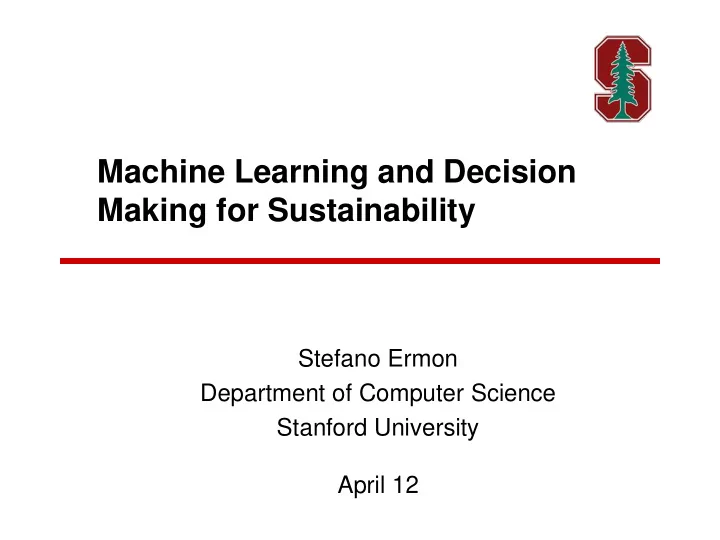

Machine Learning and Decision Making for Sustainability Stefano Ermon Department of Computer Science Stanford University April 12
Overview Stanford Artificial Intelligence Lab Fellow, Woods Institute for the Environment Computational Big Data Sustainability Technology Society Push Pull Sensing revolution Artificial Intelligence 2
ML and Decision Making for Sustainability Vision: sustainability challenges as control problems Algorithmic challenges and Data opportunities at every step – Data acquisition and interpretation Models – Model fitting – Decision making and policy optimization Policy 3
Computational Sustainability Decision making and optimization Poverty traps natural resources management Poverty mapping Water and weather Optimization systems modeling of energy systems Machine Learning Large unstructured datasets Materials discovery for energy applications 4
Summary • Introduction • Machine Learning for Public Policy • AI for Sustainable Energy • Conclusion 5
UN’s Global Goals for Sustainable Development The 2030 Development Agenda ( Transforming our world) 1. End extreme poverty 2. Fight inequality & injustice 3. Fix climate change 6
Data scarcity • Expensive to conduct surveys • Poor spatial and temporal resolution • Questionable data quality 7
Satellite imagery is low-cost and globally available Shipping records Agricultural yield Inventory estimates Deforestation rate Simultaneously becoming cheaper and higher resolution (DigitalGlobe, Planet Labs, Skybox, etc.) 8
What if … we could infer socioeconomic indicators from large-scale, remotely-sensed data? 9
Standard supervised learning won’t work Input Output Poverty, wealth, Model child mortality, etc. - Lots of unlabeled data (images) - Very little labeled training data (few thousand data points) - Nontrivial for humans (hard to crowdsource labels) 11
Transfer learning overcomes data scarcity Transfer learning: Use knowledge gained from one task to solve a different (but related) task Train here Perform here Transfer 12
Nighttime lights as proxy for economic development 13
Step 1: Predict nighttime light intensities B. Nighttime light intensities Deep learning training model images sampled from these locations C. Poverty measures A. Satellite images 14
Training data on the proxy task is plentiful Labeled input/output training pairs ( ) Low nightlight , intensity training … images sampled from ( ) these High nightlight , locations intensity Millions of training images 15
Images summarized as low-dimensional feature vectors Convolutional Inputs: daytime Neural Network Outputs: Nighttime satellite images (CNN) light intensities {Low, Medium, High} f 1 f 2 … f 4096 16
Model learns relevant features automatically f 10 f 1 Satellite image Filter activation map Overlaid image No supervision beyond nighttime lights - no labeled 17 example of what a road looks like was provided!
Transfer Learning Feature Inputs: daytime Outputs: Nighttime Learning satellite images light intensities {Low, Medium, High} Target task f 1 Socioeconomic f 2 … outcomes Nonlinear mapping f 4096 18
We can differentiate different levels of poverty 2 indicators: • Consumption expenditures Predicted ($/cap/day) • Household assets We outperform recent methods Observed consumption ($/cap/day) based on mobile call record data Blumenstock et al. (2015) Predicting Poverty and Wealth from Mobile Phone Metadata, Science 19
Models travels well across borders Can make predictions Models trained in one country perform well in in countries where no other countries training data exists 20
Scalable High Resolution Poverty Maps Run the model on about 500,000 images from Uganda: Most up-to-date map Scalable and inexpensive approach to generate high resolution maps. 21
22
Ongoing work • Describe, model, and predict changes over time • Incorporate new data sources (phone data, crowdsourcing, etc.) Credit: premise.com • Mapping and estimating crop yields 1 st prize at INFORMS yield prediction challenge – 23
Summary • Introduction • Machine Learning for Public Policy • AI for Sustainable Energy • Conclusion 24
Computational Sustainability Optimization Poverty traps natural resources management Poverty mapping Groundwater and Optimization weather systems of energy modeling systems Large Datasets Artificial Intelligence and Machine Learning Energy Materials discovery 25
White House Materials Genome Initiative Goal Accelerate the pace and reduce the cost of discovery, and deployment of advanced material systems 20 years 5 years Very exciting new research area for Computer Science and Big Data techniques 26
Vision: AI for materials research High throughput Domain Experiment experiments Knowledge Design Data analysis Automatic Data Analysis Stanford Linear Accelerator Cornell High Energy Synchrotron Source Caltech Energy Materials Center at Cornell 27
Slide courtesy of Apurva Mehta and Yijin Liu, SLAC monochromator intensit y 4 million XANES spectrums collected in a few minutes with 30 nm spatial resolution. 28
Identify materials Pattern Decomposition with Complex Combinatorial Constraints: Application to Materials Discovery. [AAAI 2015] 29
Vision: AI for materials research Improved Data Collection High throughput Experiment Domain experiments Design Knowledge Data analysis Stanford Linear Accelerator Cornell High Energy Synchrotron Source Caltech Energy Materials Center at Cornell 30
LCLS tuning at SLAC Linac Coherent Light Source (LCLS) is the world's first X-ray laser. 10 billion times brighter than any other X-ray source before it Very complex machine, difficult to operate, requires manual tuning (hundreds of hours per year) Operating cost close to $1,000 per minute – want to make parameter tuning as robust and as quick as possible 31
Bayesian Optimization for LCLS Archiving system : records almost 200,000 independent variables once a second, and goes back several years Bayesian optimization : – Works by seeking promising points that aren’t already explored – Sound way to deal with the classic exploration vs exploitation tradeoff Sparse Gaussian Processes for Bayesian Optimization [under review at UAI-16] 32
Vision: AI for materials research Preliminary work on dieletric screening via quantum simulations High throughput Domain Experiment experiments Knowledge Design Data analysis Stanford Linear Accelerator Cornell High Energy Synchrotron Source Caltech Energy Materials Center at Cornell 33
Summary • Introduction • Machine Learning for Public Policy • AI for Sustainable Energy • Conclusion 34
Conclusions • Growing concerns about the threats of Artificial Intelligence to the future of humanity • Recent advances in AI also create enormous opportunities for having deeply beneficial influences on society (energy, sustainability, …) Sustainability Sciences Computational • Exciting opportunities for Computer Science research Sustainability Computational Sciences 35
Recommend
More recommend